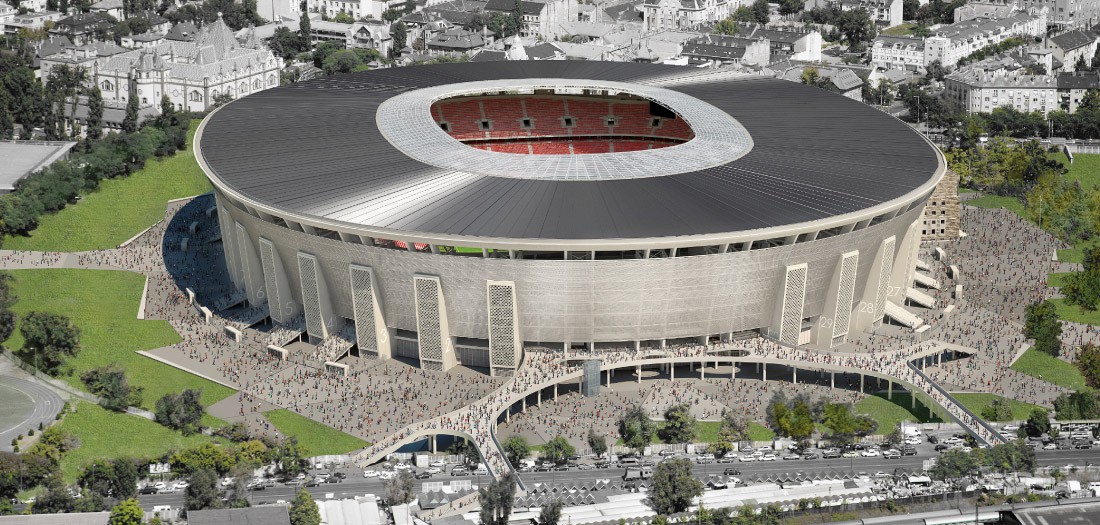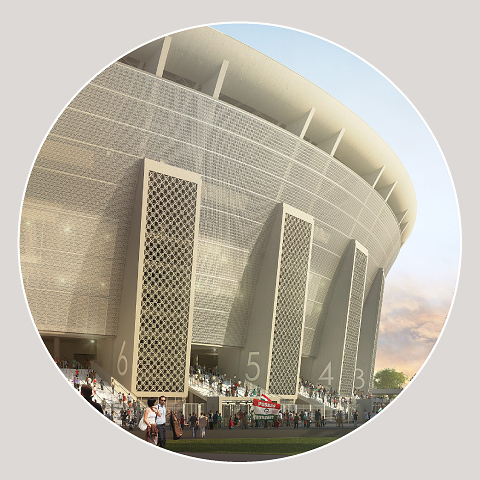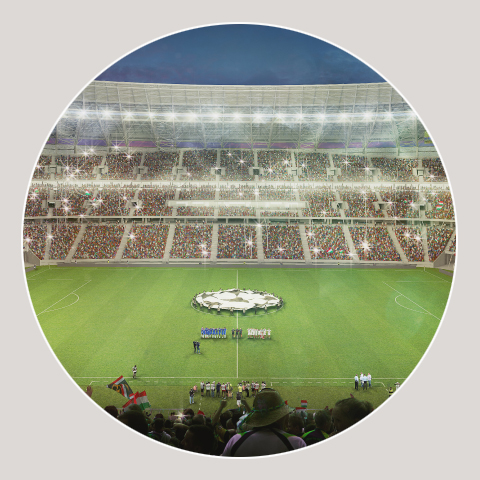Puskás Ferenc Stadium in Budapest, Hungary
New stadium with in-built wave
On a historic site in Budapest, a state-of-the-art stadium of the highest UEFA category is being built for the 2020 UEFA European Football Championship. One of its distinctive features is the wave form on the third tier.
The new stadium is designed to accommodate 68,000 spectators and meet the requirements of the highest UEFA category 4. This means it is approved for the holding not only of three group games and one round-of-16 match at Euro 2020, but also for future Champions and Europa League matches, inclusive of finals. It will be possible to play soccer as well as 20 other sports here.
Planning kicks off in 2008
The initial planning for a new stadium took place back in 2008. As a result, the plans for the construction of the new national stadium had already taken definite shape when Budapest put in its bid in 2012 to host UEFA Euro 2020. To celebrate the 60th anniversary of the European Football Championship, the tournament is being played uniquely in 12 European cities, i.e. right across Europe. The decisive reasons for building the new stadium in Budapest were the safety shortcomings of the old Puskás Ferenc Stadium that was built on the same site from 1948 to 1953. At the end, the stadium could support a gate of only about 28,000 of its original 104,000 spectator capacity.
The demolition of the old stadium got underway in 2015, with the eastern main building with the characteristic Olympic rings being retained. After modernization, it will become home to a sport museum. The distinctive ornaments of the old staircase towers will also be replicated in the new structure.
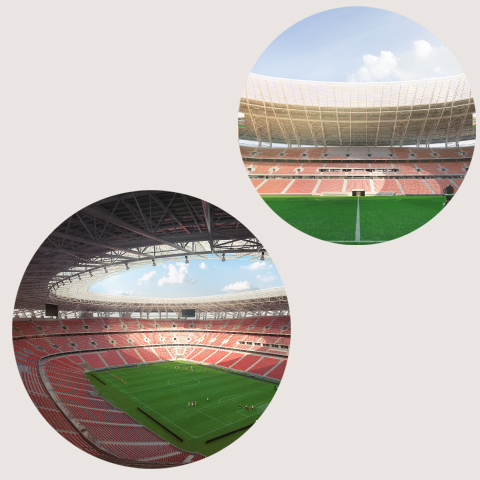
The wave, lending a dynamic element to the stadium’s appearance, can be seen on the uppermost of the three spectator tiers. Left: The HFI-welded tubes from Mannesmann Line Pipe are key structural elements of the new stadium‘s roof structure. All images: ©www.mnsk.hu
HFI-welded steel tubes are key elements of the roof structure.

Along with technology and costs, the closeness of our Hungarian colleagues in the trade to their final customers was certainly also crucial.Guido Ludwig, Regional Sales Manager
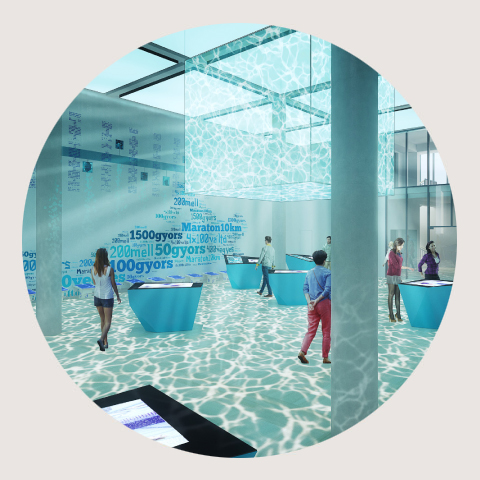
The eastern main building of the old stadium is to be modernized and converted into a multi-media sports museum. Image: ©www.mnsk.hu
National project award
The new national stadium is to be built to the design by Hungarian architect György Skardelli of KÖZTI Architects & Engineers. Among other things, it envisages giving the upper spectator tier a wave shape, which will make a lively impression in a packed house and add visual interest for spectators themselves. The construction contract was awarded in spring 2017 to leading Hungarian contractors ZÁÉV Construction Private Ltd. and Magyar Építő Zrt. They now have to master this task within
20 months and finish the stadium on time. The reason for this is UEFA’s stipulation that the stadium be completed by the end of 2019. The contractors have also indicated their agreement to contractual penalties for failure to meet the deadline. And UEFA is serious about deadlines, as Belgium experienced to its chagrin when Brussels was scrubbed by UEFA as a venue at the beginning of December 2017 because the building permit for an envisaged new stadium still was not on the table. Instead, the planned games will now take place in London and the opening match in Rome.
Advantages of HFI welding and customer proximity
Together with Salzgitter Mannesmann Stahlhandel in Hungary, Mannesmann Line Pipe has supplied a total of roughly 1,000 t of HFI-welded tubes in diameters of 508 mm and wall thicknesses of up to 25 mm. The lengths range from 8.3 to 12.4 meters.
Regional Sales Manager Guido Ludwig has been supervising the project on behalf of Mannesmann Line Pipe from the beginning: “One of the decisive factors for contract award was undoubtedly the wall thickness of 25 mm, which currently no other supplier in Europe is capable of supplying HFI-welded. The associated cost reduction over seamless tubes speaks for itself.” However, Ludwig is convinced that customer proximity also played an important part. “Along with technology and costs, the closeness of our Hungarian colleagues in the trade was also certainly crucial as they know and are capable of gauging the mentality and needs of the final customer on the ground better than us from here in Germany.”
Ludwig was responsible for the punctual delivery of the ordered quantities. Some of the tubes produced at the Hamm location went to the stockyard in Hungary, while others were sent straight to the steel construction company for further processing. This is where the tubes, before being supplied to the site, are prepared for their role in the roof structure of the new national stadium.
Ludwig sums up: “I can’t wait to see the first televised pictures of the new stadium in connection with Euro 2020. Maybe the German team will even play in Budapest – in which case, I’d obviously love to see the game live!”
UEFA Euro 2020 – a pan-European soccer event
As a unique event in celebration of the 60th anniversary of the UEFA European Football Championship, the 16th tournament will be held not in 1 or 2 countries, but in 12 cities in 12 countries. One of these is the Hungarian capital with its new stadium in Budapest.
Euro 2020 is due to kick off in the Stadio Olimpico in Rome on June 12 and end in London’s Wembley Stadium on July 12, 2020. Incidentally, Hungary as one of the host nations has not automatically qualified for the championship. The qualifiers are taking place from March to November 2019, with the last four places being determined in the play-offs of the UEFA Nations League in March 2020. Only after qualifying will the planned group matches be played in Budapest with Hungarian participation. If not, the Hungarian fans will be guests in their own stadium.
The new Puskás Ferenc Stadium in Budapest
The new stadium on the old site will have a capacity of 67,889. With a height of 51 m and a transparent exterior membrane with a multi-media projection surface, it is certain to become a new icon of the Hungarian capital.
As a venue for the Euro 2020 soccer tournament, three group games and one round-of-16 match are scheduled to take place there. The architect’s design envisages eleven stories and three spectator tiers, with a wave shape on the top one. Along with soccer, the stadium is intended for 20 other sports.
New stadium building for events and excitement
On a total floor space of roughly 200,000 square meters, the interior will also provide space for a 150-room hotel, a conference center for 800 guests, administration and business offices, numerous indoor sports facilities, VIP areas and restaurants.
Ferenc Puskás, Hungary’s greatest-ever soccer player
The “old” Puskás Ferenc Stadium was named after Hungarian soccer legend Ferenc Puskás (1927–2006) in 2001. He was among other things captain of the Hungarian national team and played for Real Madrid from 1958. There he won the European Champion Clubs’ Cup three times and the Spanish championship several times. Even today he is considered Hungary’s greatest soccer player of all time. On its completion in 1953, the stadium originally had space for over 100,000 spectators. For safety reasons, only 28,300 seats were available when it was closed in 2015. So it was high time for a replacement.
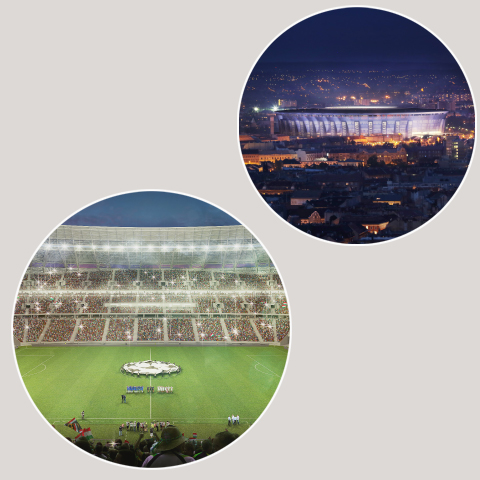
Three group matches and one round-of-16 match are scheduled in the new stadium at UEFA Euro 2020.
All images: ©www.mnsk.hu
